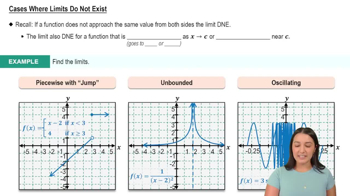Here are the essential concepts you must grasp in order to answer the question correctly.
Limits
A limit is a fundamental concept in calculus that describes the behavior of a function as its input approaches a certain value. It helps in understanding the function's behavior near points of interest, including points of discontinuity or where the function may not be explicitly defined. Evaluating limits is crucial for determining the continuity and differentiability of functions.
Recommended video:
Graphing Functions
Graphing functions involves plotting the values of a function on a coordinate system to visualize its behavior. This process can reveal important features such as intercepts, asymptotes, and intervals of increase or decrease. Using a graphing utility allows for experimentation with different viewing windows, which can help in identifying the limits and overall shape of the function.
Recommended video:
Graph of Sine and Cosine Function
Asymptotic Behavior
Asymptotic behavior refers to how a function behaves as it approaches a certain point, particularly at infinity or near points of discontinuity. In the context of limits, understanding asymptotic behavior is essential for determining the value of a limit as the input approaches a specific value, such as -2 in this case. It often involves analyzing the function's growth rates and identifying any vertical or horizontal asymptotes.
Recommended video:
Cases Where Limits Do Not Exist
 Verified step by step guidance
Verified step by step guidance Verified video answer for a similar problem:
Verified video answer for a similar problem:



 5:21m
5:21m